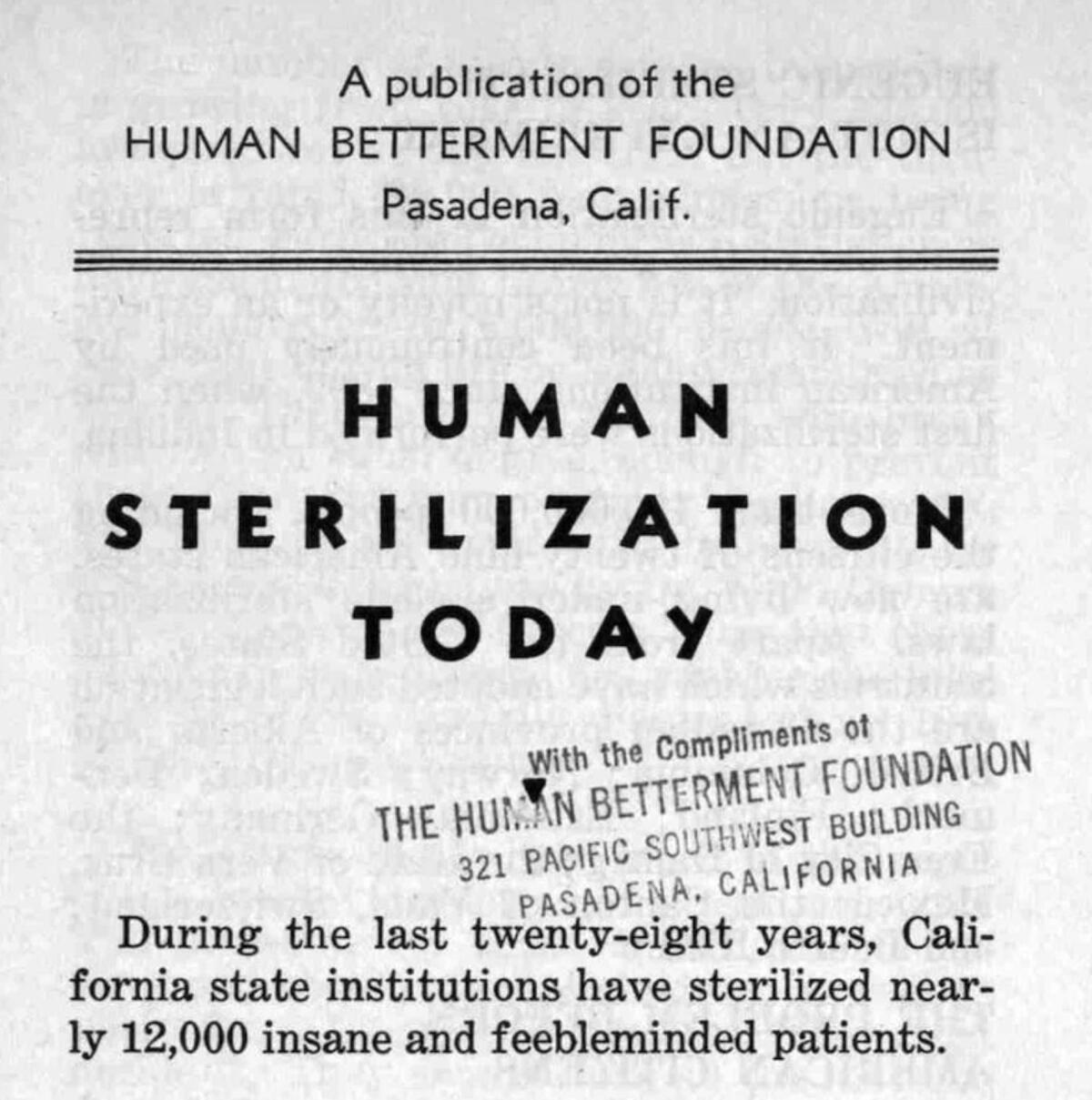Column: Caltech faces reckoning over its links to eugenics and sterilization movement

- Share via
To the ever lengthening list of institutions facing a reckoning with their racist pasts, add the California Institute of Technology.
A petition calling for the removal of the name of Robert A. Millikan from buildings, programs and open spaces on the Pasadena campus has gathered 862 signatures since June 28, according to its originator, Michael Chwe, who received his bachelor’s degree in economics from Caltech in 1985 and is now a professor of political science at UCLA. The signatories include 51 faculty members and 448 alumni.
The organizers aim to force Caltech to recognize Millikan’s role in promoting the openly racist doctrine of eugenics and policies of forced sterilization and segregation in schools and housing.
Robert Millikan is the patron saint of Caltech.
— Michael Chwe, sponsor of a petition to remove Millikan’s name from the Caltech campus
“He was not a bit player, but an important operative in this campaign,” says Anthony M. Platt, a scholar at UC Berkeley who has studied Millikan’s role as a leader of the Human Betterment Foundation, a group of wealthy and distinguished Californians whose advocacy of eugenics and forced sterilization influenced Nazi policies in the 1930s and 1940s.
The petition’s goals could produce an earth-shaking reassessment of Caltech’s self-image. Few historical figures occupy as revered a stature as Millikan does at Caltech. He is typically given credit for starting the conversion of the provincial Throop University into the global research powerhouse it is today.
Yet other similarly august figures have been or are being dethroned by their institutions. Perhaps most notable is the removal by Princeton of the name of Woodrow Wilson from a residential college and its public policy school. That’s in belated acknowledgement of Wilson’s uncompromising racism as president of Princeton, where he refused to admit any Black students, and as U.S. president, when he resegregated a federal civil service that had already become integrated.
Caltech is gingerly taking note of the movement to remove Millikan’s name. “We take seriously the concerns raised by members of our community on this matter,” Shayna Chabner, the university’s chief communications officer, told me by email.
Among its steps is “establishing a task force that is representative of Caltech’s community — including trustees, alumni, students, faculty, postdoctoral scholars, and staff — to study and advise on Caltech’s policy for naming buildings on campus: past, present, and future.”
‘Empathy’ on 1927 Supreme Court might have saved thousands from the knife
The university also has pledged to publish more detailed data about the diversity of its faculty, staff, and students, conduct a “campus climate survey” to glean the personal experiences of Caltech students and provide unconscious bias training for search committees on the campus.
This appears to be a response to a June 25 statement by the the Black Scientists and Engineers of Caltech asserting that a lack of racial diversity permeates the campus. Of 1,299 graduate students at Caltech, the group says, only 11 are Black.
Millikan was Caltech’s first Nobel laureate — in physics in 1923, for establishing the elementary charge of the electron — and served as its president (technically chairman of the executive council) for 24 years, longer than anyone else.
His name adorns buildings, rooms and spaces across the campus; the nose on his bust overlooking a campus walkway has been worn to a bronze luster by generations of students rubbing it for luck before taking their exams.
During his reign at Caltech, from 1921 to 1945, Millikan was one of the best known and most respected scientists in the country. Simultaneously, he was helping to steer the Human Betterment Foundation, which tarnishes a legacy that extends well beyond Caltech — Millikan’s name adorns streets and public schools across the Southland.
The Human Betterment Foundation was the brainchild of Ezra S. Gosney, who had settled in Pasadena with a fortune from farming and real estate and established the organization in 1929. The group’s membership roll guaranteed it a wide influence.
It included Rufus von KleinSmid, then the president of USC, Lewis Terman, a Stanford psychologist who pioneered the study of IQ, and Harry Chandler, the publisher of the Los Angeles Times.
(The petition also calls for renaming Caltech’s Gosney Research Fund and Harry Chandler Dining Hall, among other facilities.)
Under Chandler’s leadership, according to Alexandra Minna Stern, a historian of eugenics, from 1935 to 1941 The Times published a weekly column titled “Social Eugenics” by one Fred Hogue, a eugenics enthusiast. In one 1936 column Hogue praised “the movement in Germany and other Nordic countries of Europe for the elimination of reproduction of the unfit.”
Arizona implements rationing for hospital care--but they won’t be alone
Millikan was not a charter member of the Human Betterment Foundation, but joined its board in 1937. His views on race and women were no secret — indeed, they were excused by Caltech faculty member David Goodstein in a 2001 defense of Millikan against old charges of academic fraud as “typical at the time of a man of his upbringing and background.”
Goodstein acknowledged that Millikan in 1936 advised Duke University not to hire a female professor of physics because there were no outstanding female physicists in the U.S.
Writing his wife from Germany around the same time, he described physicist Paul Ehrenfest as “a Polish or Hungarian Jew” whose “suavity and ingratiating manner are a bit Hebraic (unfortunately) and to be fair, perhaps I ought to say too that his genial openmindedness, extraordinarily quick perception and air of universal interest are also characteristic of his race.”
The purported science of eugenics blanketed the world in the 1920s and 1930s. Its American manifestation, Platt observes, was noxiously right-wing, aimed not merely at promoting procreation among the ostensible elites — that is, wealthy and white — but the suppression of procreation by groups deemed to be undesirable.
The notion reached as high as the U.S. Supreme Court and the notorious 1927 decision by Oliver Wendell Holmes in the case of Buck vs. Bell, in which Holmes upheld Virginia’s forced sterilization law by referring to the Buck family, which was Black, as a hive of “degenerate offspring” and declaring, “Three generations of imbeciles are enough.” In fact the Buck women were of normal intelligence but were sterilized without their knowledge.
American eugenicists found common cause with the emerging Nazi regime in Germany. In a 1934 article, Paul Popenoe, a lead researcher for the Human Betterment Foundation, saluted Adolf Hitler and the Nazis for their determination to achieve “national regeneration” by applying “biological principles to human society.”
Popenoe quoted liberally from Hitler’s “Mein Kampf,” including his admonition that “to prevent defective persons from producing equally defective offspring, is an act dictated by the clearest light of reason.... the most human act of mankind.”
Popenoe reproduced the Nazi sterilization law in its entirety and observed that while the law “may be considered better than the sterilization laws of most American states, the success...depends on conservative, sympathetic, and intelligent administration. Apparently the Nazis are doing their best to prevent criticism on this score.”

Throughout the 1930s, Stern found, “California and German eugenicists traded ideas...and complimented each other’s escalating sterilization programs.” California, indeed, was a leader in the American sterilization movement.
Its forced sterilization law, enacted in 1909, was one of the first in the nation, and by 1938 its more than 12,000 involuntary sterilizations accounted for nearly half of all those nationwide. By 1979, when the state law was repealed, some 20,000 sterilizations had been performed.
Notes Platt: “Nazi racial scientists were excited to find supporters and endorsers in the U.S., and the foundation was excited that they were getting praise from a Western European country.”
John Wayne wasn’t a hero. He played one in the movies, not in real life.
During Millikan’s tenure at Caltech, Platt reports, a quota existed allowing for the appointment of only one Jewish full-time faculty member per year.
Perhaps most tellingly, Millikan oversaw the acquisition of the Human Betterment Foundation archives and its financial assets for Caltech after Gosney’s death in 1942. The terms accepted by Caltech called for the income from Caltech’s resulting Gosney Research Fund to be “devoted in perpetuity to the promotion of research into the biological bases of human qualities.”
The names of members and trustees of the Human Betterment Foundation have been relegated to the trash heap by their institutions. USC last month removed Von KleinSmid’s name and bust from a central building on its downtown Los Angeles campus.
The Palo Alto school district has voted to take Terman’s name off a middle school. Pasadena’s Polytechnic School has removed Gosney’s name from a hallway named for him, and its Neighborhood Unitarian Universalist Church, which Millikan co-founded, last year removed his name from a room in its building.
Is Caltech up to the task of confronting the past of its revered figure? The action may be inescapable, but it may not be easy.
“Robert Millikan is the patron saint of Caltech,” Chwe acknowledges, though he says that younger faculty members and undergraduates seem to be less invested in continuing to honor him than others.
Platt argues that a reconsideration of Millikan and the institution’s links to the eugenics movement is long overdue. It missed a chance to do so in 1942, “when they took over the papers of the Human Betterment Foundation without questioning what it stood for.”
Even after World War II, when the consequences of the Nazi embrace of eugenics were well known, “there was no reflection at Caltech of what Millikan had participated in.” That time may have come.
More to Read
Inside the business of entertainment
The Wide Shot brings you news, analysis and insights on everything from streaming wars to production — and what it all means for the future.
You may occasionally receive promotional content from the Los Angeles Times.












